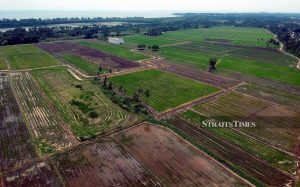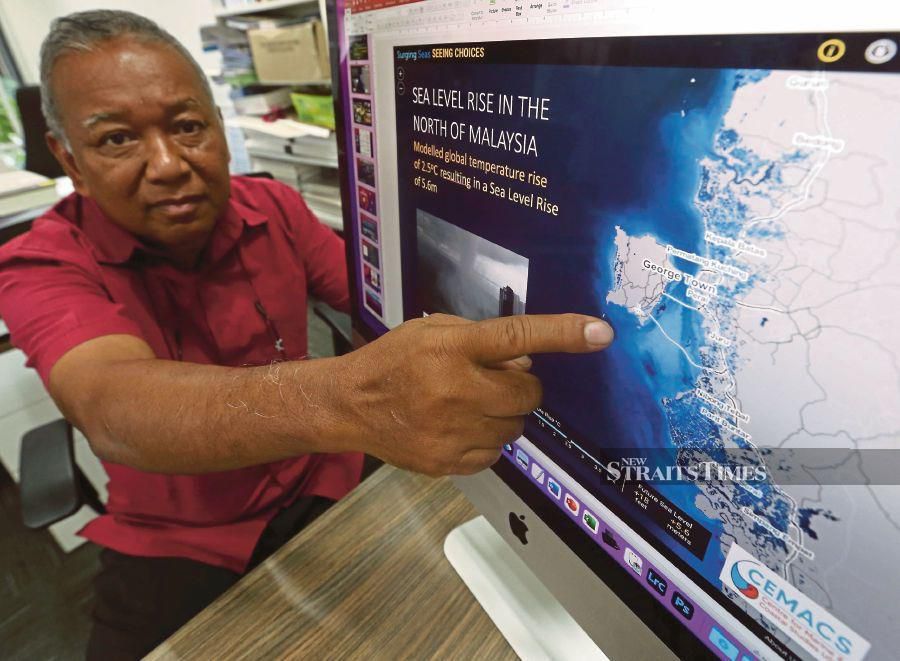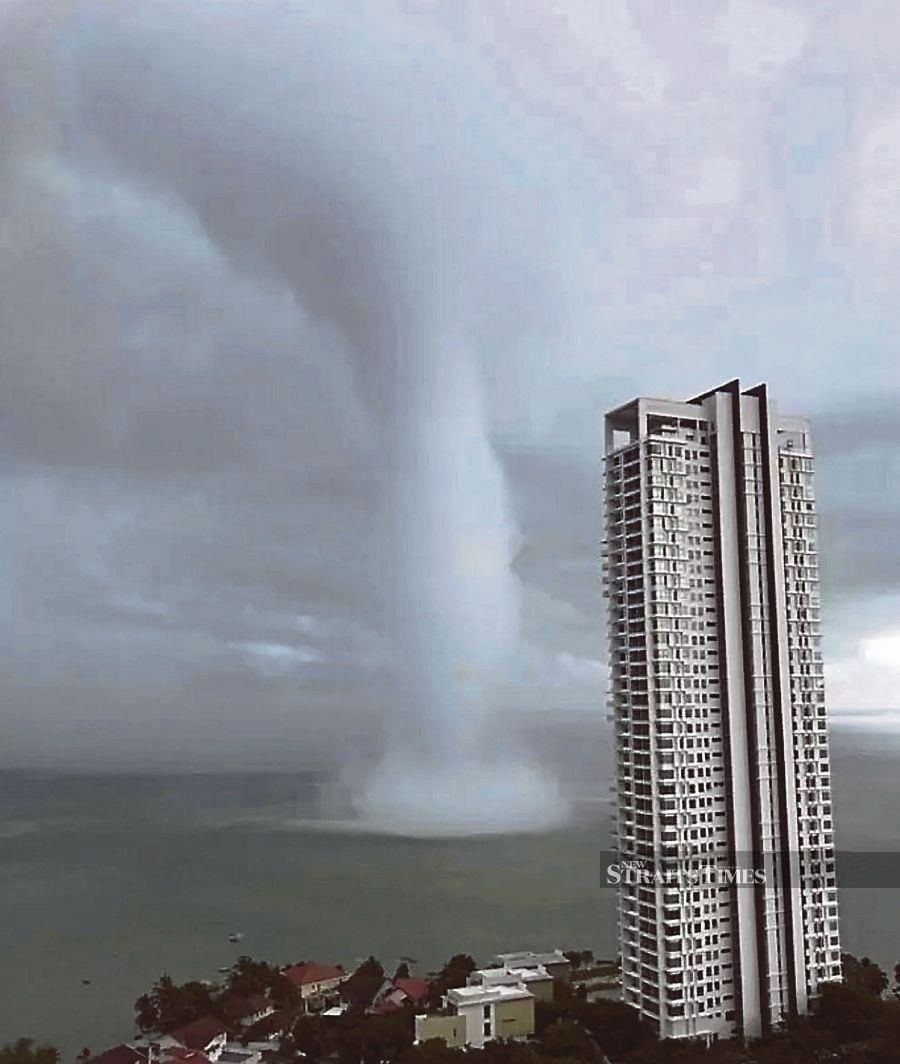Underwater in 10 years

“Yes, they should be very worried. If I want to buy a house in (mainland) Penang, I would be lying if I said I was not concerned if the sea was going to be part of my land, say in 10 years or 20 years. Of course I want my house to stand there as long as possible.
(NST) – As rising temperatures cause ice caps and glaciers to melt at ever-increasing rates, one marine environment expert has warned that low-lying areas, particularly in Penang and Kedah, may become part of the sea if nothing is done.
Universiti Sains Malaysia Centre for Marine and Coastal Studies’ (CEMACS) honorary professor Datuk Dr Zulfigar Yasin said Kepala Batas and Juru in Seberang Prai, Penang, would be under water within a decade at the earliest, if the temperature and sea levels continued to rise unabated due to climate change.
He said the situation would be worse in neighbouring Kedah.
“A very important climate crisis is looming and we are feeling the impact now. You may not feel it significantly because we are experiencing it on a gradual scale. It is difficult to determine (the scale), but within this lifetime, you will feel the big impact.
“You will definitely experience the full brunt of climate change for the rest of your life. I am not crying wolf or making it more complicated, but it is serious and something we need to face,” he told the New Straits Times in an exclusive interview.
In April 5 last year, United Nations Secretary-General António Guterres described the latest report of the Intergovernmental Panel on Climate Change (IPCC) as “a litany of broken climate promises” and reminded the world that it was “on a fast track to climate disaster”.

According to the World Bank, between 1970 and 2013, Peninsular Malaysia, Sabah and Sarawak had experienced a surface mean temperature increase of 0.14°C to 0.25°C per decade.
Surface maximum temperatures had increased by 0.17°C to 0.22°C per decade in the same period; surface minimum temperatures increased by 0.20°C to 0.32°C per decade.
The World Bank also reported a study that assessed the historical sea level rise from 1993 to 2015 at around 3.3mm per year in the east of Malaysia and around 5mm per year in the west of Malaysia.
It also said rising sea levels were predicted to have a negative impact on the country’s coastal zones, with the east coast being severely affected.
It was suggested that by 2040, potentially all of the country’s mangrove zones might be submerged and by 2060, industrial zones would be affected.
When the sea level rises by one metre, this will put around 7,000 sq km of coastal land at risk.
As agricultural estates in the country are located near coastal areas, approximately six per cent of palm oil and four per cent of rubber production would be at risk.
IMMEDIATE CONCERN
Zulfigar, who is also the head of Penang Institute’s Heritage and Urban Studies Programme, said those living in coastal areas on the mainland should be concerned.
“Yes, they should be very worried. If I want to buy a house in (mainland) Penang, I would be lying if I said I was not concerned if the sea was going to be part of my land, say in 10 years or 20 years. Of course I want my house to stand there as long as possible.
“Many people may not be aware of what is going to hit them. I do not expect the knowledge (of climate change and climate crisis) to be equally disseminated to all and everyone will be in the know.
“But we need to push this idea about talking about climate change, climate crisis. That it is real and it is here.
“I think the situation is urgent but we still have time and I think there is growing awareness, maybe not as fast as we want it to be, but we need to prioritise our conscience,” he added.
Zulfigar said scientists agreed that the increase in temperatures and sea levels was happening.
He said there was no definite figure for the rise in temperature on the local scale, which was one of the many problems in describing climate change.
As such, he said, Malaysia had to act on many scales as climate change was bound to affect everyone.

“The rise in temperature is non-linear. If you look at it, it is increasing, but it is increasing faster and faster. The sea level is also going to increase as the polar icecaps melt.
“Every time, a couple of years, the IPCC will look at the data. In the past, they said the increase was 1°C. Now, it is 1.5°C.
“So, if you increase the temperature of the sea, the sea level is going to rise, but now we are talking about a rise of temperature of 1.5°C in the next few decades, maybe over 20 to 30 years.
“That increase is gradual. You may say that it is slow, that the number may look small, but it is actually a lot. This is because to increase the sea level, which is so big, by a little, it takes a lot.
“This 1.5°C has many repercussions. What is now land will be submerged by the sea. Kepala Batas, Juru… it is worse for Kedah.
“If you look at these, most of the affected areas are padi fields in the lowlands.
“They will become saline and we will have no more rice to eat,” he said, adding that there were ways to mitigate this problem when the time comes.
WORSE ON MAINLAND
Zulfigar said, compared with Penang island, the mainland would be hard hit as the coastal areas were not naturally raised.
He explained that some areas on the island were built for reclamation and had been raised.
“From a scientific perspective, those areas are safe. That is why there is less likelihood of Penang island to be underwater compared with the mainland.
“We don’t want to jump to conclusions but this is what the data tells us.
“I am not saying that reclamation is good or bad, but it is very clear now, the mainland is at higher risk than the island because these are natural areas which have not been raised.
“So the sea can come in, and as it goes in further inland, where our main highway is, it will cut off the connection and then this will cause another impact,” he said.
Zulfigar said, as it is, Penang was already experiencing coastal erosion, fish deaths, flooding and extreme weather on a minor scale — things which have not occurred before.

He said attributing such things to reclamation work was one thing, but climate change was something that was “in the background”.
“If you ask the scientists, it is very hard for us to attribute (blame to any one thing) as we have to be very sure. But in our gut, we have a kind of indication.
“For example, where fish deaths are concerned, this did not happen a lot before. It is happening now. And our sea is filled with jelly fish.
“In the past, we had not seen some of the extreme weather events. Now, we get to see waterspouts in Tanjung Tokong, something which I had never imagined seeing in my lifetime here.
“As the sea levels rise, it is not going to rise calmly. The sea is going to be very angry. It is going to come with all these hazards,” he asserted.
ADAPTATION IS KEY
Zulfigar said for Malaysia, even though mitigation was a solution, adaptation was much more important.
“We have to adapt. So, coming back, if the padi we planted is very prone to salt water, should we not be switching to padi that is more resistant to salt water? Where is this happening in Malaysia? Nowhere.
“We are not as ready as we should be. I am saying that sometimes we need to invent things, but at other times, when people have done the right thing, we just follow what they do. China has started growing saline padi.
“Or maybe we should eat less rice. We should change our diet to maybe (more) green aquaculture.
“If you think about it, climate change actually gives you an opportunity.
“I give you an example. If you are an expert in saline padi, you are going to be rich because it is an opportunity and everybody will want that.
“So there are opportunities and at CEMACS, we are looking at alternative food systems, the green food such as small/micro algae, seaweed and bottom feeders, which are not affected by climate change.
“This is because when one system starts to die, another system starts to increase and we need to focus on this opportunity,” he said, adding that in Penang, people used to eat a lot of seaweed in the past, known otherwise as the “caviar of the sea”.
Zulfigar said Penang has always been ahead of things, with the creation of new marine sanctuaries like a specialised marine park near the Middle Bank, which would be geared to being more resilient, more adaptable to climate change.
“Nowhere else in the country do we have this. Nowhere else in Southeast Asia has this. In fact, the United Nations is looking at Middle Bank.
“This used to be wasteland. Penang converted it into an area where we can grow green food and be more resilient to climate change. This is a new model of marine sanctuary and we created it to survive.
“It is a good area to start something and we believe we don’t have all the answers, but this is a ground where we can test things out and find out whether we can use it or whether there is greater chance of success or not. But this is certainly something we have to start now.”
ALL-OF-SOCIETY APPROACH
Moving forward, Zulfigar said it should be useful for all strata of society, whether politicians and administrators or the people, to deal with the issue of climate change.
“We are already experiencing the effects. It should be an indication that it is going to come and the implication of this, according to the UN secretary-general, is that those who are not ready for climate change will be relegated to the Third World.
“Are we going to be part of the Third World or are we going to be part of the developed nations, in that we are more ready?
“Already, people in other nations are talking about getting ready and I think Malaysia has the capability to do it. After all, Malaysia is a relatively educated nation, small in population and large in assets.
“On other nations that are already getting ready, Indonesia is moving its capital to Nusantara from Jakarta. Singapore has raised the new airport. Vietnam is experimenting on saline crops.
“You ask me when should we be ready? Our neighbours are all ready. What is Malaysia waiting for?”
Zulfigar said the country needed better engagement to resolve the climate crisis, suggesting that climate change should be part of the formal education system.
“It has to be everybody’s issue and not just the Natural Resources, Environment and Climate Change Ministry’s.
“Each and every single ministry should make climate its priority… not only a normal priority, but a big indication of responsibility. Climate change is too important to just leave it to the government.
“There are many phases we have to go through to get ready for climate crisis. What is important is that we need to localise our plans and readiness because we work on that level by taking into consideration things on a bigger scale — the global, regional scale.
“The first phase is communication, awareness and education. We need to do that now so that the people are aware of the climate crisis. We need to have a better resolution for what is going to happen,” he said.

